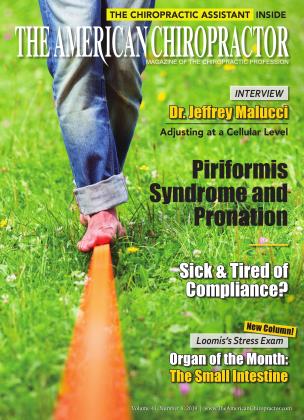Stress Screening Evaluation
TECHNIQUE
Howard F. Loomis
Jr., DC
This series of articles is devoted to introducing a simple, convenient, and quick screening procedure for chiropractors to use, when needed, before treating their patients. It can be performed on all new patients. It can also be performed on existing patients where progress has been slow or is not meeting expectations. It is especially useful for returning patients before deciding on a course of treatment.
You might ask why chiropractors need a stress exam. The answer comes from the question: Why do we run examinations at all? The answer is:
• To identify the source of stress.
• To identify involved structures and organs.
• To rule out pathology.
• To determine a plan of treatment.
• To monitor progress.
A major factor in treating a patient is recognizing whether a structural or visceral source of stress is causing the involuntary muscle contractions associated with your treatment protocol. Last month, we wrote about the role of bone in the maintenance of homeostasis.
Maintaining relatively constant conditions in the extracellular fluids and the constant need to oppose gravity are major factors in symptoms involving stress and energy deficiency.
Organ of the Month
This month, we highlight the small intestine.
That may seem like a strange organ with which to begin, but involuntary muscle contractions of visceral origin from the small intestine are found around the umbilicus. This is the abdominal area that physical diagnosis texts identify being involved with colic and even the beginning of acute appendicitis.
"Can the affected organ or tissue respond adequately to sympathetic or endocrine stimulation?
Structural Relationships
Structurally, you will find involuntary muscle contractions across the suprascapular fossa involving the supraspinatus and upper trapezius muscles. Restriction of passive shoulder abduction and reduced range of motion in the sternoclavicular joint are both key factors.
Because of the visceral and structural connections involved with stress and dysfunction of the small intestine, the patient often wifi present with soreness in the shoulder and symptoms involving the arm and hand.
Embryological Connections
The question is: Why the visceralstructural connections? Consider the suspensory muscle of the duodenum, also known as the ligament of Treitz. It is a thin muscle connecting the junction between the duodenum and jejunum to connective tissue below the diaphragm surrounding the superior mesenteric and celiac arteries. It assists in moving digested food particles (chyme) from the duodenum into the jejunum. Movement of the diaphragm when breathing facilitates this function. Recall that the spinal innervation of the diaphragm comes from two sources:
• The phrenic nerve, which originates from C3 to C5 and is pulled downward as the embryo develops and moves to separate the thorax from the abdomen. Involuntary muscle contractions in this area affect the brachial plexus and shoulder, arm, and hand syndromes.
• Sympathetic innervation of the diaphragm originates from T4 to T9. Involuntary muscle contractions in this area result in loss of the normal thoracic kyphosis, which is easily recognized and known as Pottenger’s saucer.
Stress-Related Symptoms
Stress, regardless of visceral, structural, or emotional source, always evokes the same physiological response cascade on the part of the hypothalamus. We are well aware of the fight-or-flight response in acute stress situations, but we often forget that the same response continues unabated if the stress continues day after day. This seems to be the case with most of our patients. The question then becomes: Can the affected organ or tissue respond adequately to sympathetic or endocrine stimulation? It will if it has the nutrients to make the energy required. However, when it doesn’t, a different symptom pattern usually develops.
Sympathetic Stimulation
Sympathetic stimulation to the small intestine inhibits both peristalsis and secretions, as it does throughout the digestive tract. This brings to mind using abdominal breathing and the suspensory muscle of the duodenum to assist in these cases.
However, if the stress has been long continued and the tissues exhausted, then removal or reduction of the stress is required before improvement can be expected. Of course, nutritional excesses are often the key in these situations.
Nutritional Considerations
Paramount in any gastrointestinal symptom pattern is the patients’ diet. Look for excessive simple sugar ingestion. Inquire into digestive symptoms and bowel elimination patterns. Nutritional supplementation should be directed at those areas as opposed to seeking a “magic symptomatic bullet” for relief.
Conclusion
My intention with this series of articles is to call to your attention that there is an opportunity for our profession to offer more to the American people than just relief from structural problems. This belief is based on the premise that stressed visceral organ dysfunctions cause involuntary muscle contractions in those muscles sharing neurological innervation. This is accepted science having been proven more than 100 years ago. This basic science concept is beyond reproach since those relationships are established in the third week of embryonic life, as we discussed in this article.
Next month, we will take a look at the visceral and structural connections of the urinary bladder.
Dr. Loomis has an extensive background in enzymes and enzyme supplements. He is the founder and president of the Food Enzyme InstituteTM. His extensive knowledge of physiology, biochemistry, and enzymology has made him a sought-after speaker and a prolific writer. The Food Enzyme Institute offers seminars to health care practitioners around the country. Dr. Loomis published ENZYMES: The Key to Health in 1999, as well as The Enzyme Advantage: For Healthcare Providers and People Who Care About Their Health, also with medical Journalist Arnold Mann, in 2015. Contact info: [email protected], 800-662-2630.
 View Full Issue
View Full Issue






